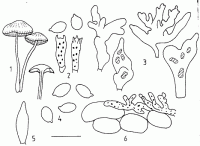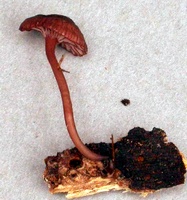|
 Mycena rubroglobulosa Mycena rubroglobulosa
BiostatusPresent in region - Indigenous. Endemic
Images (click to enlarge)
Caption: Fig. 7 M. rubroglobulosa. 1. basidiomes. 2. basidia. 3. cheilocystidia. 4. basidiospores. 5. pleurocystidium. 6. pileipellis and subpellis elements. | 
Owner: P. Leonard |
Article: Segedin, B.P. (1991). Studies in the Agaricales of New Zealand: some Mycena species in sections Longisetae, Polyadelpha, Rubromarginatae, Galactopoda, Lactipedes, and Calodontes. New Zealand Journal of Botany 29(1): 43-62 (http://www.rsnz.org/publish/abstracts.php).
Description: Pileus 10-15 mm
diam., convex, brownish orange (7C K&W) to rust brown (7D7) in the centre,
shilling, smooth to slightly rugulose in the middle, pellucid striate at the
margin, margin even. Lamellae decurrent to slightly arcuate, narrow (2-3 mm),
3-4 series, up to 20 reaching the stipe, reddish-brown (9B6) with a vinaceous
sheen and purplish vinaceous margin. Slightly interveined. Stipe 20-30 X 2-3
mm, concolorous with the pileus but slightly paler above and darker below, even,
dry, shining, with quite long, brownish hairs at the base. Flesh yellowish.
Odor and taste not observed.
Spore print white.
Spores 5.5-6.5 X 3-4 (5.8 X 3.6) µm., Q=1.6, ellipsoid, uniform in size, hyaline,
faintly amyloid, thin-walled. Basidia 15 X 5µm., 4-spored, containing conspicuous
red globules. Cheilocystidia 3 5-45 X 10-13 µm. (at base), forming a thick layer,
lageniform to subclavate with knobbly, simple or diverticulate protuberances,
with red plasmatic pigment. Pleurocystidia 30 X 9 µm., broadly fuse, tapering
at the apex, hyaline. Trama of more or less parallel hyphae of inflated cells
(4-10 µm. diam.) with yellow plasmatic pigment; some short and narrow conducting
hyphae and nests of cells showing reddish-brown, granular contents; tissue strongly
vinaceous in Melzer's. Pileipellis of repent hyphae, with simple to fairly complex,
erect protuberances with distinctive reddish-brown, plasmatic globules. Subpellis
of globose cells up to 25 µm. diam., with yellow plasmatic pigment. Context
of more or less parallel hyphae 3-7 µm. diam., with yellow plasmatic pigment
and with clusters of cells with brown, granular contents and a few short conducting
hyphae. Stipe of long narrow cells, no conducting hyphae or caulocystidia; some
basal, brown hairs seen in other collections not very noticeable in the type
material. Flesh yellow. Clamp connections present.
Habitat: HABITAT: Among mosses in soil and on wood in podocarp
forest.
Notes: ETYMOLOGY: The name refers to the conspicuous, red,
plasmatic globules in the tissues, particularly the basidia.
M. rubroglobulosa shares numerous characters with M. singeri Lodge (Lodge 1988)
and M. endoglobulosa Sing. (Singer 1978) in colour and shape of cystidia,
pileipellis characters and conducting elements. It differs from M. singeri
in the shape and larger size of the spores, presence of globules of red material
(insoluble in KOH) in the basidia as well as the cystidia, and the absence of
caulocystidia, and from M. endoglobulosa, which has larger spores, and
no pleurocystidia, lactifers, or pigment in the pileipellis.
|